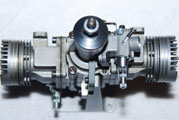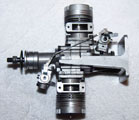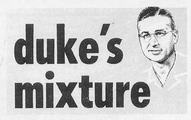|
|
"So how did you get the nickname Duke, Mr. Fox"? "Well, son, it just happens to be my 100% given name". "Oh"! And Duke Fox had politely answered the time-honored question once more. When he died on February 15, 1991, the FOX MANUFACTURING CO. of 530 Towson Ave., Fort Smith, Arkansas 72901 wrote a gentle and loving commentary on his life in their March 15 "Fox Newsletter", noting he had been a major force in the hobby for over 43 years. And he surely had!
Duke's father was in the automobile business and young Fox became quite familiar with cylinders, pistons and how the engines operated. Around the age of nine he encountered his first model airplane ads in "Popular Mechanics" and "Bill Barnes" who started putting a model plane in each issue. Duke was hooked and at the time in 1928 there were no model shops so magazine ordering was it. The Junior Birdmen stirred things up in the San Francisco area with contests every weekend where the Foxes lived. After high school graduation in 1938 Duke went to Modesto Jr. College (Aircraft engineering) and worked for Hughes.
His service years were spent at Wright Field while keeping up his active modeling. While in the service he worked out the design and production drawings for the long shaft Fox .59 spark ignition and after finding a partner (Arnold) who owned shop facilities, managed to put it into production, only to see failure after a few months of production by the partners business troubles. Duke went to work for Douglas while building some 20 experimental engine types in his home wotkshop. Using the Ohlsson 23 for weight and dimensional guides, but wishing a much more powerful engine, Duke brought out his first 35 with production in his Mother's garage. The first 35s were sold successfully and quickly found a "home" with the new control line stunt fellows!
With production increasing he moved his shop/facilities to North Hollywood and there brought out the 29 stunt and 29R, resurrected the 59 as a glow and basking in the success of his engine sales made an exhaustive search for an area suited to his type of business. Thus in 1955 he chose Fort Smith, Arkansas for central distribution, lower production costs and the ease of getting to model meets around the country. From Ft. Smith he began one of the most prolific design and production efforts in the USA, from the 049s to the huge 1.20 twin R/C and the current l5s, 25s, 40s and 60s, some of the most powerful model engines ever manufactured. But Duke avoided the "new" four-stroke field which he left to others. Looking back on his production in earlier years, Duke noted that one of his very best designs was the .07 cid, developed for and sold exclusively to Comet for their ready-to-fly plastic control-line airplanes.
In later years he published some of the most beautiful product catalogs and also had beautiful red, white and blue engine ads to tout his wares, also packed in his "Made in USA" colorful boxes. The Fox "line" was expanded to include his universally used glow plugs and castor oil based fuels (he started a small revolution in the fuel field when he put the formula of the contents on each can). Duke branched briefly into the making of Kart engines and in later years, spinners, motor mounts, shaft extensions, prop reamers, wrenches, taps, silencers, many "U" control products, pressure fittings, fuel line, 'bulbs, filters and all of the highest quality. Most have come and gone from his catalogs over the years.
In the 70's, rumors of Duke's incarceration for child pornography were whispered around the industry but never discussed in "polite circles." Sadly it was true. Afterwards he delved more strongly than ever into his model business and the 80's brought some of his best work..the "Eagle 60" was low cost to compete with the new imports and the all new Fox 60 "Hawk" gussied up with bright red anodized head and prop driver/bearing cover and the power to meet the competition. The huge "78" was the largest US mfg engine at the time. In 1977-78 Duke had begun work on the totally redesigned and massive "Eagle II" 60, while also planning for his first production twin 1.20 R/C two-cycle model engine.
This air-cooled, horizontally-opposed, simultaneous-firing, twin-cylinder, two-stroke cycle with dual shaft rotary-valve induction and Schnuerle scavenging model airplane engine, was manufactured in a single 2000 engine "batch." It came onto the market in the summer of 1980 at $250 retail and was the most powerful two-stroke for sale rated at 3.0 hp, at 14,000 rpms on a 13/6 propellor. It shared most of the big Eagle II features, could pe regarded as two sixties placed back to back, each with its own carburetor and rotary valve and almost with its own crank chamber. Modelers fell all over themselves to be the first to own one in their area. Most unfortunately this powerful engine had two problems right out of the box. First, it had the "old style" Fox carbs which were difficult to master. A few weeks after the introduction Duke Fox replaced the carbs with his new MK.X with conventional barrel throttle. This helped the second problem of the tendency of one cylinder to die but by no means cured the problem. Modelers had "cooled off" on the big twin because of the problems and sales dropped off. Clarence Lee's full page commentary in RCM put it this way..."shortly after release of the engine, fellows began to experience idle and accelleration problems. As is typical of all glow twins, one cylinder would have a tendency to load up and die." Clarence went on to note the time he spent with little success in trying to adjust the carbs and eliminate the problem, and the interesting solution.
In November 1980, Clarence and Duke were at a U-control contest in the Sepulveda Basin, (Calif.) and struck up a conversation regarding the flameout problem of the twin, and Duke noted "they" had found by blocking off the two boost ports this would eliminate the problem with a minimum power loss. Simply put, blocking off the boost ports directly opposite the exhaust stopped the incoming fuel charge from putting out the glow plug. This was accomplished by rotating 1800 the paper gasket that seals the joining surface of the cylinder to the crankcase. But by then the market for large and powerful engines was growing with new four-strokers and "chainsaw" type engines and the twin's potential was lost. And loud...gosh one can't imagine its vroooommmm!
This incredible twin, American made, limited production, and the only genuine Fox ever manufactured, is just now some 15 years off the market, beginning to catch on with multicylinder engine collectors. Peter Chinn, in the July 1980 MAN has a detailed (as only he could) article on the Fox twin, but treads lightly on the "problems."
In the 1980s Duke Fox began to write a series of advertisements come commentaries called "Duke's Mixture" in MAN and his expertise resulted in two definitive articles of the dozen or so he wrote. In his August, 1989 MAN Article, on model engine fuels, (methanol, nitromethane, temperature ranges, castor oil, and percentages of mixture) he wrote the best information ever published. In a previous column, in June, 1988 also in MAN he wrote on "the merits of ball bearings, vs bronze bushings, vs aluminum for crankshaft main bearings and also on the relative merits of lapped-ring and ABC piston/cylinder combinations"...a genuine treatise. I quote his last paragraph which more than any comments I have found, sum up the Duke Fox lifetime of work.
"Our Fox 19BB, 40BB and 50BB are our top line motors. Materials used are top quality and the best we have found for the purpose. All cylinders and bearing surfaces have been hand fitted for optimum clearance. All_motors have been test run at full power and all needle valves have been adjusted to normal operating adjustment. We pay less attention to cosmetics than our competitors, but nobody takes the care we do to insure that your motor will start readily, run right, and fly your airplane with authority. Buy one-you will be happy that you did"!
Anyone got an extra "split case" 19 or "bathtub" 29 for sale or trade?
 Back to Model Engine News Home
Back to Model Engine News Home
Back to Janson Index
Please submit all questions and comments to [email protected]




